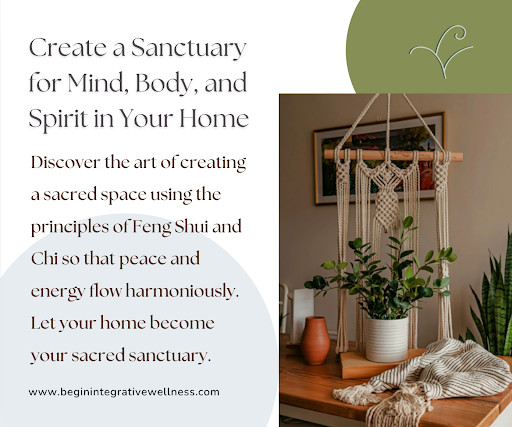
In our often overstimulating world, having a dedicated sacred space at home can provide a much-needed sanctuary for reflection, relaxation, and rejuvenation. By incorporating principles of Feng Shui and the concept of chi—the life force energy that flows through all things—you can create a harmonious environment that promotes balance and well-being. These guiding principles help ensure your sacred space not only looks serene but also feels energetically supportive, calming, and restorative.
Feng Shui teaches us to be mindful of energy flow within a space. Elements like the orientation of furniture, the colors used, and the placement of meaningful items all influence how chi moves through the room. By consciously designing with these guidelines in mind, you can transform even the smallest corner into a place of intentional peace.
Here’s how to get started:
1. Choose Your Space Wisely
Select a location in your home that feels comfortable and private. It doesn’t need to be an entire room—a cozy corner, a windowsill, or even a small nook can work beautifully. Aim for a spot where distractions are minimal, and you can retreat without interruption.
From a Feng Shui perspective, choose a location where you can see the entrance to the space, as this provides a sense of security. Avoid placing your back directly to the door, which can create a feeling of vulnerability and disrupt your focus. If needed, use a reflective surface like a mirror to give you a view of the doorway.
2. Personalize the Aesthetic with Feng Shui in Mind
Your sacred space should reflect your personal style while also promoting harmony and balance. Keep these Feng Shui principles in mind:
- Soft Lighting: Use candles, string lights, or a gentle lamp to create a soothing ambiance. Avoid harsh overhead lighting that can create energetic imbalance.
- Natural Elements: Incorporate plants, flowers, crystals, or stones to ground the space in nature, but don’t overcrowd. Place greenery in the east or southeast to enhance growth and vitality.
- Textures and Colors: Choose calming hues like soft blues, greens, or neutrals. Avoid overly stimulating colors like bright reds unless they serve a specific purpose. Balance textures by mixing smooth surfaces with soft, inviting fabrics. Consider earthy tones to bring stability and harmony.
3. Include Symbols of Meaning Strategically
Bring in items that hold personal significance or inspiration, such as:
- A favorite book, journal, or set of affirmation cards placed in a way that feels inviting.
- Artwork, statues, or imagery that resonates with your spirituality or values, positioned to draw your eye without overwhelming the space.
- Memorabilia, such as family photos or mementos, placed thoughtfully to avoid visual clutter.
Place these items where they will draw positive energy and create balance. For example, keep heavy objects grounded and avoid stacking items too high, which can feel destabilizing.
4. Embrace Aromatherapy
Scents can play a powerful role in creating a sacred atmosphere. Experiment with:
- Essential oils like lavender, sandalwood, or eucalyptus. Use a diffuser in the southeast or south for relaxation and clarity.
- Incense sticks or cones to cleanse the energy in the space.
- Fresh flowers or natural potpourri, keeping them fresh to avoid stagnant energy.
5. Design for Functionality with Flow
Think about how you plan to use your sacred space and arrange it to support effortless movement. For example:
- If it’s for meditation, place a cushion facing an open view or a calming focal point.
- For journaling, include a small table or lap desk that doesn’t block the natural flow of the room.
- For yoga, leave enough room for your mat and ensure the area feels open and uncluttered.
Ensure there are no physical obstructions in pathways to keep chi moving smoothly. Use rounded furniture edges where possible to avoid sharp lines cutting into the space’s energy.
6. Minimize Clutter to Maximize Chi
A sacred space should feel calming and intentional. Keep the area tidy and free of excess. Avoid sharp-edged furniture pointing toward your seat (referred to as "poison arrows" in Feng Shui), which can disrupt the energy flow. Opt for concealed storage solutions if necessary, and remove items that don’t serve your purpose in the space.
7. Infuse the Space with Ritual
Create rituals to use in your sacred space. These could include:
- Morning meditations or breathwork.
- Evening gratitude journaling.
- Weekly intention-setting.
- Reflective reading or listening to calming music.
Position objects used in these rituals where they are easily accessible but do not crowd the space.
8. Make It Sacred Through Use
What transforms a corner into a sacred space is how you engage with it. Dedicate time to regularly use your space for practices that restore your energy and deepen your connection to yourself and your surroundings.
9. Adapt as Needed with Energy in Mind
Over time, your needs may change. Allow your sacred space to evolve with you. Swap out items, change the layout, or refresh the decor to keep it aligned with your current intentions. Regularly cleanse the space—energetically with sage or sound, and physically by dusting and tidying—to maintain vibrant energy.
Creating a sacred space is a deeply personal process. Trust your instincts and let the space reflect your unique journey. By carving out this corner of peace, you’re not just decorating—you’re making a commitment to prioritize your well-being.
Do you have a sacred space at home? Share your favorite tips or photos in the comments below! Let’s inspire each other to build havens of peace in our everyday lives.
___________________
Begin Within
and align with the rhythm of nature and self.













0 Comments